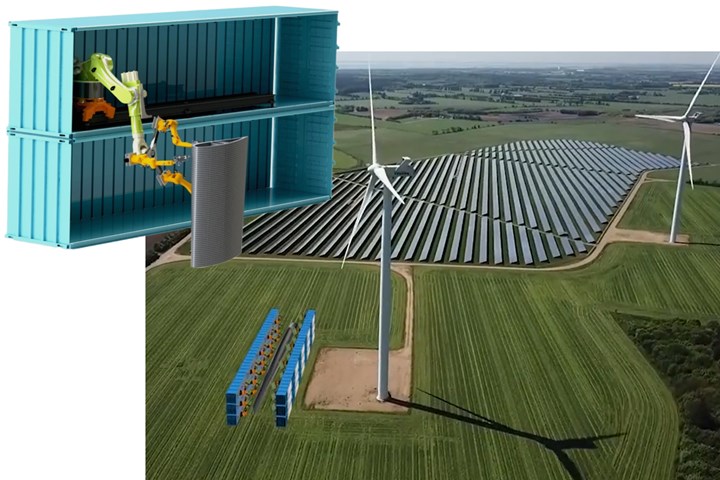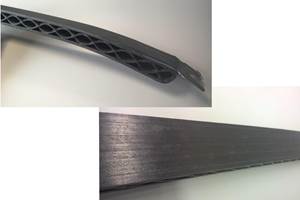Orbital Composites to demonstrate containerized 3D printing robots for AM wind blade manufacture
Project aims to demonstrate additive manufacturing of >100-meter-long composite wind blades with >25% reduced cost.
Orbital Composites (San Jose, Calif., U.S.) will collaborate with Oak Ridge National Laboratory (Oak Ridge, Knoxville, Tenn., U.S.) and the University of Maine (UMaine, Orono, Maine, U.S.) to advance on-site, high-throughput manufacturing of wind blades with large-scale continuous fiber additive manufacturing via a $4 million grant from the U.S. Dept. of Energy (DOE), Office of Energy Efficiency and Renewable Energy (EERE). Orbital notes that this project will also enable the demonstration/potential validation use of its containerized 3D printing robots for wind blade manufacture.
In addition to ORNL’s previous collaboration with Sandia National Laboratory, for a 3D-printed wind turbine blade mold, and UMaine’s 120-foot-long 3D printer, Orbital Composites says it has been quietly pioneering its own accomplishments under its Mobile Robotic Additive Manufacturing with Continuous Fiber, a modular platform which uses a twelve-axis robot arm to enable AM of non-planar surfaces. Having already demonstrated thermoplastic and thermoset AM reinforced with continuous carbon and glass fibers, the company has a vision of eventually building large scale-up systems capable of printing entire wind blades greater than 100 meters in length. Currently, the system’s ORB OS software allows multi-robot collaboration as well.
This goal comes about due to several challenges the wind industry still faces. For example, according to Orbital, with low-cost energy expected to reach 35% of global energy demand by 2050 (driven by wind blade cost reductions), optimal locations for onshore wind farms are forcing operators to build wind farms in harder-to-reach areas. In addition to this, blade transportation is often limited in the U.S. to blade lengths between 53-62 meters by road and rail infrastructure, constraining future cost-reduction potential. A landmark study by the International Energy Agency (IEA, Paris, France) suggests on-site manufacturing as one of the disruptive technologies needed to continue to reduce the cost of wind energy.
Use of Orbital Composites’ containerized robotics, therefore, can potentially make on-site manufacturing a reality. “Shipping containers are the most versatile and lowest-cost method for global relocation,” says Amolak Badesha, co-founder and CEO of Orbital Composites. “Mold transportation costs can be greatly reduced if 3D printing feedstock loaded shipping containers are being transported instead of mold surfaces. Modular, mobile robotics facilitate global logistics.”
A mobile factory may also be the solution for crane use, particularly as offshore wind turbines are built bigger. “The sheer scale of off-shore deployment vessels is an impressive feat, one unmatched by terrestrial cranes. Cranes big enough for land-based, 100-meter-long blades do not exist,” Amolak says. “If the shipping containerized factory can be placed directly beneath the tower, then blade hoist and repair systems may be incorporated into the shipping container superstructure.”
The project
The DOE proposal calls for demonstrating the use of AM for cost-effective scaling of large blade sizes (greater than 100-meter-length), novel AM-enabled blade designs and lower tooling costs. Orbital Composites’ proposal answered the call by offering a comprehensive solution showing a path to manufacturing and transportation cost reduction by more than 25%, increased throughput speeds and reduced labor compared to conventional blade manufacturing processes. Orbital Composites says it can also show how AM can enable a more than 50% reduction in new blade design lead times, allowing wind blade OEMs to introduce a large variety of site-optimized blades with higher efficiency and lower cost of energy (COE).
UMaine will also be incorporating its Offshore Wind Lab to test the wind blade’s strength and fatigue aging of the AM blades, as well as how well they survive lightning strikes.
Orbital Composites also intends to create new, repairable wind turbine blades. “We will push the envelope with mobile manufacturing and embedded sensors,” says Cole Nielsen, founder and CTO of Orbital Composites. “Digital twin operating systems and mobilized industry 4.0 robots can enable wind turbine systems to be monitored, evaluated, tuned and repaired. Mobile robots are truly disruptive tech.”
Potential for future applications
The technical objective of this combined mission is to make on-site manufacturing of wind blades a possibility. According to Orbital Composites, disrupting the current wind turbine blade industry is quite possible; once the technology has successfully been created, the company says, demand for longer wind blades has the potential to soar.
Further, 100-meter continuous fiber structures may revolutionize another industry in the near future: rockets. This claim may be compared to the Saturn V rocket with 110.6-meter-tall and 10.1-meter-wide launch vehicles, or SpaceX’s current Starship plan, which call for a 122-meter-tall and ~10-meter-wide rocket. Both rockets are currently metallic.
Related Content
3D-printed CFRP tools for serial production of composite landing flaps
GKN Aerospace Munich and CEAD develop printed tooling with short and continuous fiber that reduces cost and increases sustainability for composites production.
Read MoreLarge-format 3D printing enables toolless, rapid production for AUVs
Dive Technologies started by 3D printing prototypes of its composite autonomous underwater vehicles, but AM became the solution for customizable, toolless production.
Read More3D printing and AFP join forces in automotive demonstrator
Bavarian auto industry and TU Munich research how to reduce molding costs by combining continuous fiber and 3D-printed composites.
Read MoreMaterials & Processes: Fabrication methods
There are numerous methods for fabricating composite components. Selection of a method for a particular part, therefore, will depend on the materials, the part design and end-use or application. Here's a guide to selection.
Read MoreRead Next
Composites end markets: Energy (2024)
Composites are used widely in oil/gas, wind and other renewable energy applications. Despite market challenges, growth potential and innovation for composites continue.
Read MoreCW’s 2024 Top Shops survey offers new approach to benchmarking
Respondents that complete the survey by April 30, 2024, have the chance to be recognized as an honoree.
Read MoreFrom the CW Archives: The tale of the thermoplastic cryotank
In 2006, guest columnist Bob Hartunian related the story of his efforts two decades prior, while at McDonnell Douglas, to develop a thermoplastic composite crytank for hydrogen storage. He learned a lot of lessons.
Read More
















.jpg;maxWidth=300;quality=90)









